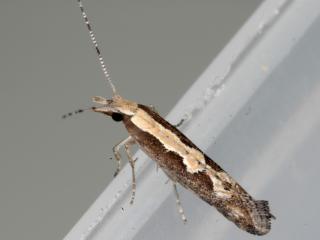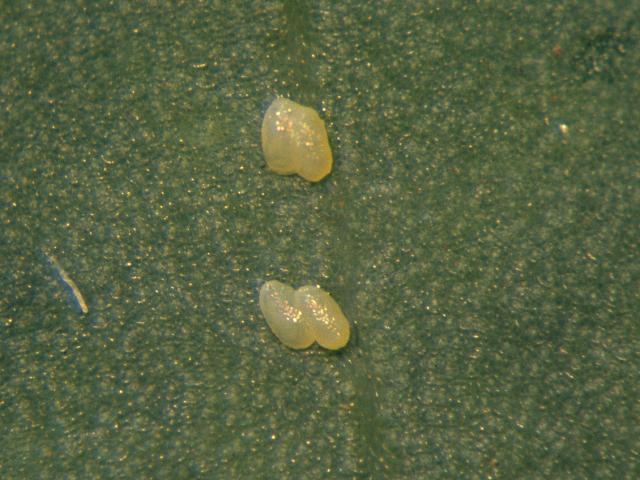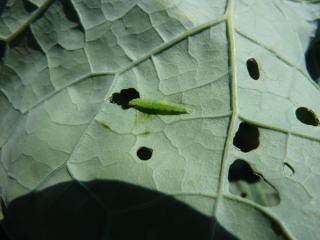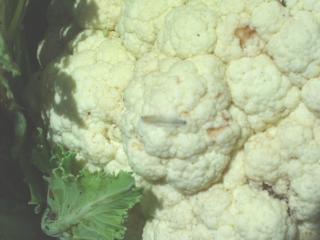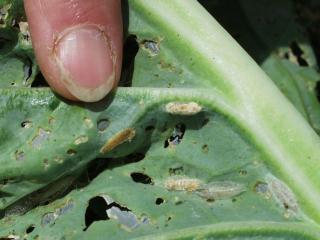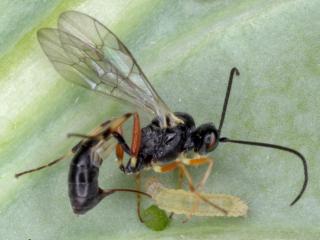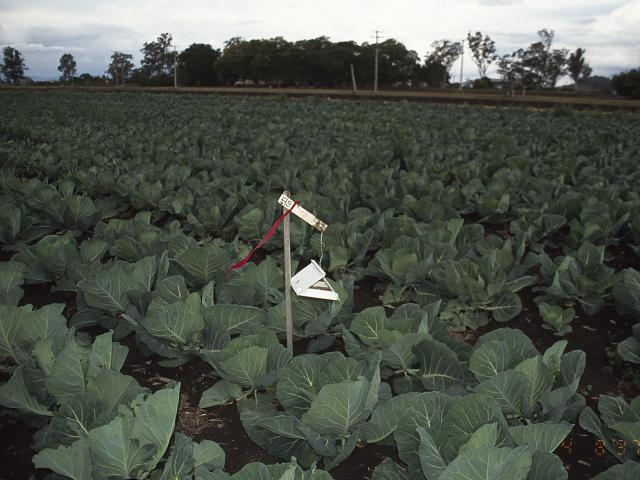Identification
Diamondback moth’s Indonesian name is "ulat kubis" and its scientific name is Plutella xylostella.
Diamondback moth adults are about 8mm long with a diamond pattern on the wings when at rest. Moths are weak fliers but their dispersal may be assisted by wind. They can infest crops from early stages through to harvest.
Eggs laid by diamondback moths are about 0.5mm long and are yellow when first laid, but darken when close to hatching.
After hatching, transparent egg shells remain. Eggs are laid singly or in small groups near veins mainly on the upper surface of brassicas leaves.
Newly emerged diamondback moth larvae burrow into leaves causing wiggly mines. Larvae are cream when young and grey/green to green as they grow larger. When disturbed, larvae wriggle forwards and backwards quickly and may leave the plant by jumping off or dangle on the end of a silken thread. Older larvae chew holes in leaves of brassica plants.
Heavy infestations of diamondback moth larvae can retard plant growth. Large larvae can feed on the curd of cauliflowers making them unmarketable.
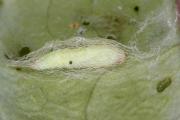
When fully fed, larvae of diamondback moth spin a silk case on the leaf surface and form a cocoon within the silk case. Cocoons are pale when young but become brown as they get older and before the moth emerges.
Management
Feeding by diamondback moth larvae can slow the growth of young plants and makes older plants unsaleable. Infestations are most destructive when plants are young.
Diamondback moth eggs and larvae are attacked by generalist predators such as spiders, ground-dwelling beetles, ladybeetles and lacewings, and insect-killing fungal diseases.
The introduced parasitic wasps Diadegma semiclausum and D. collaris have established in highland regions of Indonesia. Diadegma also occurs in Western Australia.
These insects help control the pest but they are killed when broad-spectrum insecticides are used.
Diamondback moth has developed resistance to all insecticides, including Bacillus thuringiensis (Bt). Not all diamondback moths in all regions are resistant to insecticides but if any insecticide is used repeatedly resistance may develop. The most effective approach to managing diamondback moth is integrated pest management where key natural enemies such as Diadegma wasps are conserved. When insecticides are required, select products that have a range of active ingredients to apply during a crop cycle to slow or avoid the development of insecticide resistance. An example of this is the two-window strategy recommended to vegetable brassicas growers which is available as a document attached to the information sheet produced by the Department of Primary Industries and Regional Development, Western Australia.
Monitor for natural enemies by holding diamondback infested cabbage leaves in jars with gauze covers for three weeks. Adult wasps like those pictured will emerge. The relative presence of wasp parasites and diamondback moth adults shows how many wasps are present in the cabbage crop.
Adult female moths produce a pheromone, or scent, which attracts males. Synthetic pheromone lures can help monitor the timing and intensity of insect infestation. When moths appear in pheromone traps, start monitoring crops. Experience with the seasonality of diamondback moths in each growing region may also indicate when monitoring of crops should commence; for example in the winter in Western Australia diamondback moth is not present. Moths start to appear during spring, but the timing of their arrival depends on weather conditions.
Monitor crops weekly for diamondback moth by checking 50 plants across the crop.
Checking for eggs provides a good indication of the potential pressure from larvae. Only plants with larvae should be recorded as infested, because most insecticides do not kill eggs.
Do not attempt to control moths with insecticide.
Spray when more than 10% plants are infested with diamondback moth larvae. This would be five of 50 plants infested.
Destroy crop residues as soon as possible after harvest.
Acknowledgment
Funding for this work to support Indonesian potato farmers and WA seed potato exports was provided by ACIAR (the Australian Centre for International Agricultural Research) and the Department of Primary Industries and Regional Development, Western Australia.

